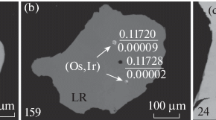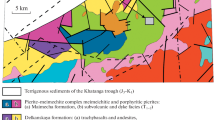Abstract
This study firstly presents chemical and initial Os-isotopic compositions of Os-Ir-Ru minerals of two ultramafic formations of Polar Siberia, which are exemplified by Guli clinopyroxene-dunite massif of the Maimecha-Kotui Province and the Kunar dunite-harzburgite massif from the Chelyuskin ultramafic belt of the Taimyr Peninsula. The study employed a range of methods, including electron microprobe analysis, negative thermal ionization mass spectrometry (N-TIMS) and laser ablation attached to an inductively coupled plasma mass spectrometry (LA MC-ICP-MS). The majority of platinum-group minerals (PGM) from the Guli massif are Os-(Ir-Ru) solid solutions or Os-rich minerals. At Kunar, minerals of Ru-Os-Ir system (i.e., osmium, ruthenium, iridium and rutheniridosmine) dominate the PGM assemblage. The ruthenium trend in the mineral compositions is due to the formation of these minerals under high pressures and temperatures at considerable depths. The 187Os/188Os values of Os-rich minerals from the Guli massif range from 0.12309 ± 0.00002 to 0.12606 ± 0.00003 (n = 168). The initial Os-isotopic composition of PGM from the central block of the Guli massif is characterized by the 187Os/188Os values, varying in the range 0.12404–0.12606. Osmiumrich minerals from the southwestern block of the Guli massif are characterized by the least “radiogenic” 187Os/188Os values (i.e., 0.12309–0.12341). Low relative to the chondritic universal reservoir (CHUR) 187Os/188Os values are indicative of a near-to-chondritic source of platinum-group elements (PGE). The most “productive” stage of PGM formation at Guli (n = 121) is recorded in the time interval of 545–615 Ma. The older model 187Os/188Os ages of osmium minerals are characteristic of the southwestern block of the Guli massif (e.g., 745–760 Ma). The results of the initial Os-isotopic composition for Os-rich alloys are consistent with a model, in which PGM were formed during multi-stage melt depletion events in the mantle. This agrees well with the suggestion that the Guli massif consists of heterogeneous blocks of ultramafic rocks. The 187Os/188Os ratio in the investigated PGM from the Kunar massif varies in a wider range (0.1094–0.1241, n = 28). For the dominant set of PGM samples (n = 25), regardless of their chemical composition, four groups of the initial osmium isotopic compositions can be estimated, with average 187Os/188Os values of 0.1217 ± 0.0002 (n = 7), 0.1223 ± 0.0002 (n = 7), 0.1230 ± 0.0002 (n = 6) and 0.1238 ± 0.0003 (n = 6), respectively. The average model Re-Os ages for the defined groups of the Kunar massif are consistent with Late Riphean age interval (e.g., 975 ± 42 Ma, 892 ± 42 Ma, 791 ± 28 Ma and 681 ± 42 Ma, respectively). Significant variations in the 187Os/188Os values and model ages for Ru-Os-Ir alloys at Kunar are close to those from other duniteharzburgite massifs of the Earth, pointing out for their prolonged multi-stage evolution within the upper mantle.
Similar content being viewed by others
References
R. Sh. Zalyaleev and V. V. Bezzubtsev, Geologiya i Geophysika 16(12), 132 (1995).
A. I. Kostoyanov and Yu. D. Pushkarev, Zavodskaya Laboratoriya. Diagnostika Materialov 64, 24 (1998).
V. G. Kuz’min, A. V. Gavrish, and A. N. Smirnov, in Resources of Taimyr, Ed. by O. N. Simonov and N. S. Malitch (VSEGEI Press, Noril’sk, 1999), Vol. 3, pp. 150–171 [in Russian].
K. N. Malitch, Platinum-Group Elements in Clinopyroxenite-Dunite Massifs of the Eastern Siberia (Geochemistry, Mineralogy, and Genesis) (Saint Petersburg Cartographic Factory VSEGEI Press, St. Petersburg, 1999) [in Russian].
K. N. Malitch and G.G. Lopatin, in Resources of Taimyr, Ed. by O. N. Simonov and N. S. Malitch (VSEGEI Press, Noril’sk, 1997), Vol. 2, pp. 86–103 [in Russian].
J. M. Bird and W. A. Bassett, J. Geophys. Res., Ser. B 85(10), 5461 (1980).
L.-J. Cabri, D. C. Harris, and T. W. Weiser, Exploration Mining Geol. 5, 73 (1996).
J. H. Chen, D. A. Papanastassiou, and G. J. Wasserburg, Geochimica et Cosmochimica Acta 62(19/20), 3379 (1998).
K. Hattori and S. R. Hart, Earth Planetary Sci. Lett. 107, 499 (1991).
S. A. Junk, Nucl. Instrum. Methods Phys. Res. Section B 181, 723 (2001).
K. N. Malitch, Chem. Geol. 208(1–4), 157 (2004).
K. N. Malitch, S. A. Junk, O. A. R. Thalhammer, et al., Canad. Mineralogist. 41, 331 (2003).
K. N. Malitch and R. K. W. Merkle, Canad. Mineralogist. 42, 631 (2004).
T. B. Massalski, Binary Alloy Phase Diagrams (Ohio, Amer. Soc. Metals, Metals Park, 1993).
M. I. Smoliar, R. J. Walker, and J. W. Morgan, Science 271, 1099 (1996).
Author information
Authors and Affiliations
Corresponding author
Additional information
Original Russian Text © K.N. Malitch, I.Yu. Badanina, A.I. Kostoyanov, 2011, published in Doklady Akademii Nauk, 2011, Vol. 440, No. 3, pp. 397–402.
The article was translated by the authors.
Rights and permissions
About this article
Cite this article
Malitch, K.N., Badanina, I.Y. & Kostoyanov, A.I. Initial Os-isotopic composition of Os-Ir-Ru alloys from ultramafic massifs of the Polar Siberia. Dokl. Earth Sc. 440, 1343–1348 (2011). https://doi.org/10.1134/S1028334X11090273
Received:
Published:
Issue Date:
DOI: https://doi.org/10.1134/S1028334X11090273




